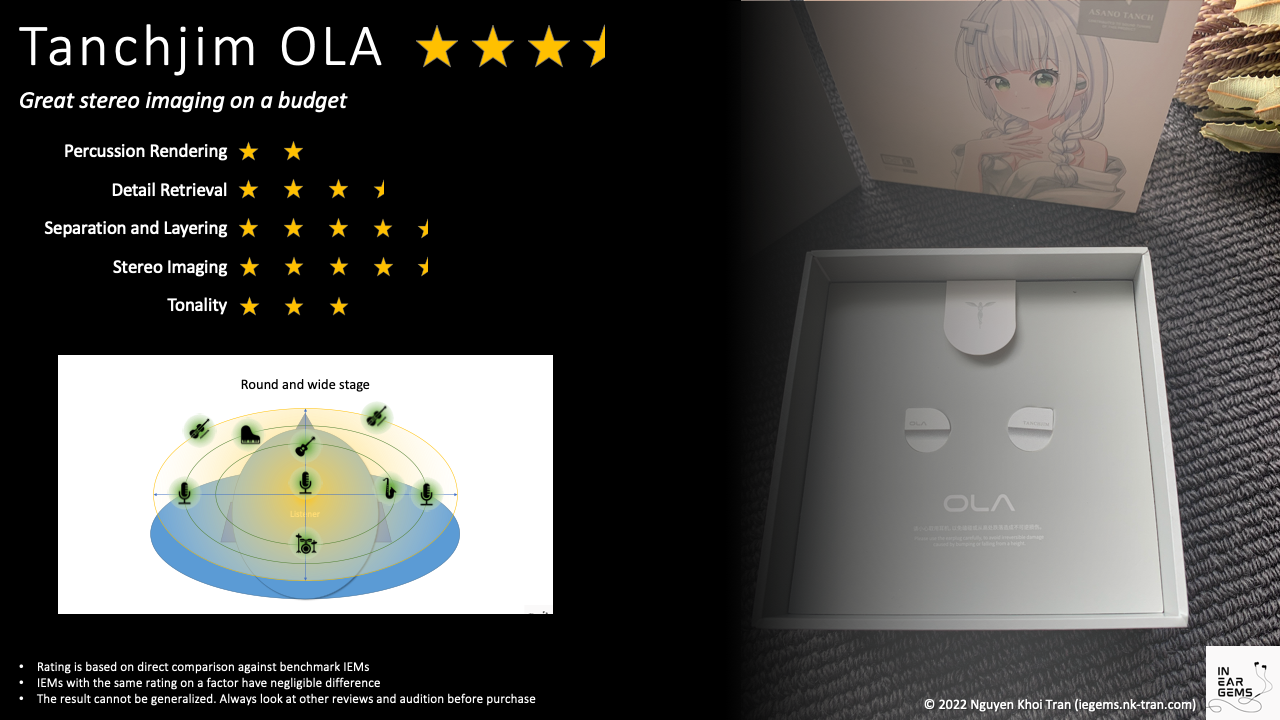Tanchjim Ola - Exceptional stereo imaging but limited by fit, bass, and resolution
tl;dr: Undeniable stereo imaging prowess. However, the detail retrieval and bass cannot catch up with the exceptional stereo imaging. The fit might also be a dealbreaker for some users.
Preample
- I purchase this unit on my own. I have no affiliation with or financial interest in Tanchjim
- All listening tests were conducted at a comfortable level where the main vocal and instruments are loud and clear
- My music library covers nostalgic pop music, epic orchestral music from Sci-fi shows, classical violin performances, piano, lo-fi beats, and a few rock songs.
- What I look for in IEM, in order of importance: 3D soundstage with a strong sense of depth, detailed across the frequency spectrum, snappy and tactile note attacks in bass and midrange, natural timbre.
- IEMs are rated with a series of A/B tests against a few benchmark IEMs. The total rating is the average of component ratings. EQ is NOT used in these tests. See the methodology for more detail.
- Price is not a factor when comparing IEMs. I want to see where an IEM fits in the “grand scheme” of things rather than in arbitrary buckets such as “budget”, “mid-fi”, and “flagship”.
- This review was done with stock bass tips, Comply foam tips, and DIY foam tips.
Non-sound aspects
I always think of Tanchjim as an unlucky fellow, always playing second fiddle despite having a similar approach to tuning and marketing to a fellow Chi-Fi company. Therefore, when Tanchjim announced a new budget IEM that focuses on stereo imaging, my curiosity got the best of me, and I blind bought it. After weeks of using and testing OLA, I am impressed.
First, let’s talk about packaging and accessories.
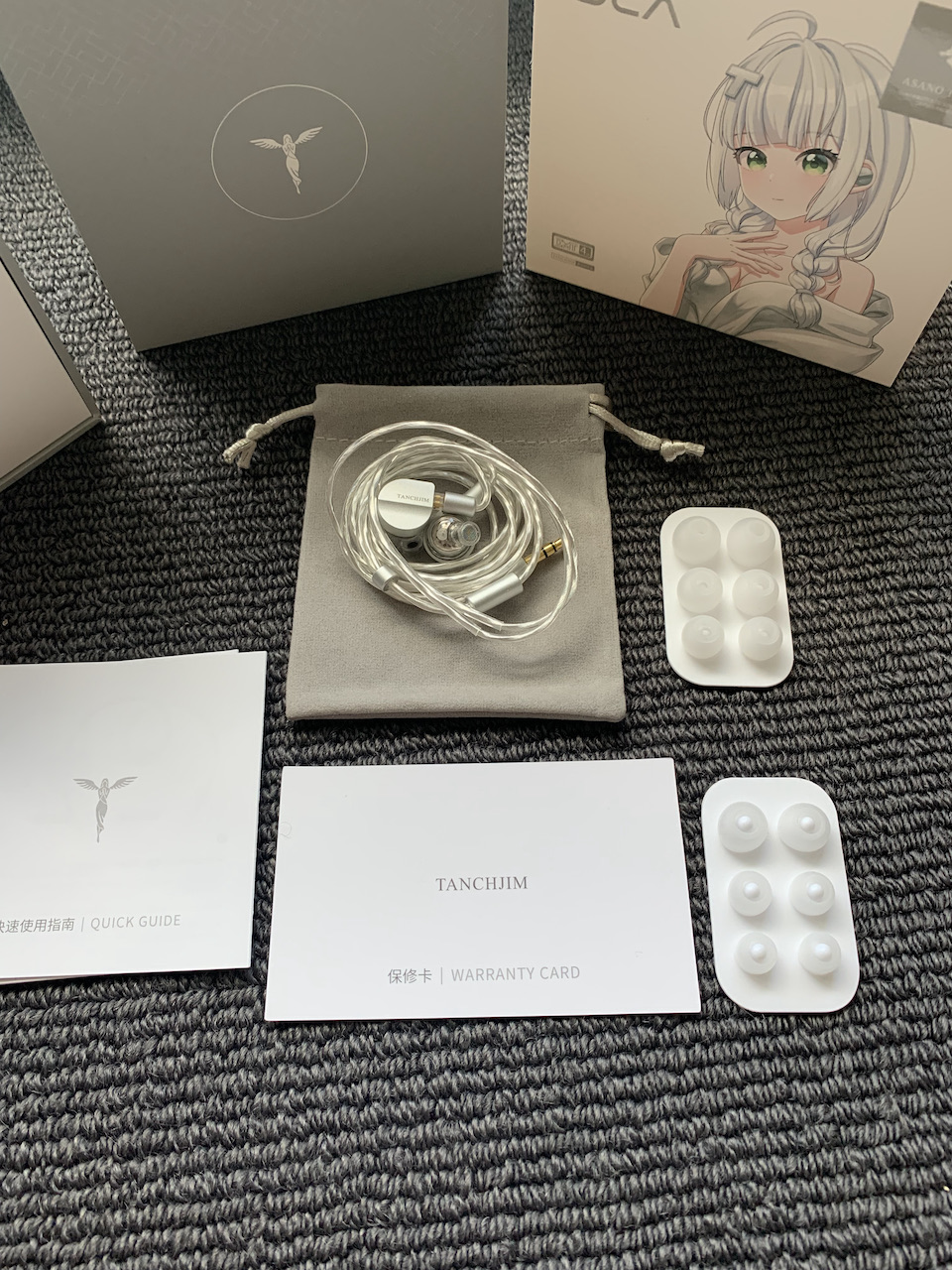
In the box, you get:
- Ear pieces
- 3 pairs of bass tips (silicone)
- 3 pairs of treble tips (silicone)
- A cloth bag for carrying
- Paper work
Whilst the amount of provided accessories is not as generous as Dunu or Fiio, the unboxing experience is quite pleasant and thoughtful, making this IEM an exciting gift for beginners.
Build-wise, OLA is very light. It seems sturdy enough, but the moulding and finishing are not as good as one imagines looking at the advertisement material. It is not a resin-filled IEM like Blessing 2 or Dunu SA6.
Fit-wise, Ola is not the easiest nor comfortable one to use. It has a large short nozzle with a thick lip, similar to those warp pipes in Super Mario games. While the nozzle is small enough to go into your ear canal, the included tips might be too thick. Unless you sort this out, you will have a very shallow fit where the IEMs are held by the tip of the ear tips rather than the entire nozzle. Such fit can change frequency response and leak bass. I ended up creating custom foam tips to ensure the best fit.
 Custom tips from foam earplugs
Custom tips from foam earplugs
Sound Analysis
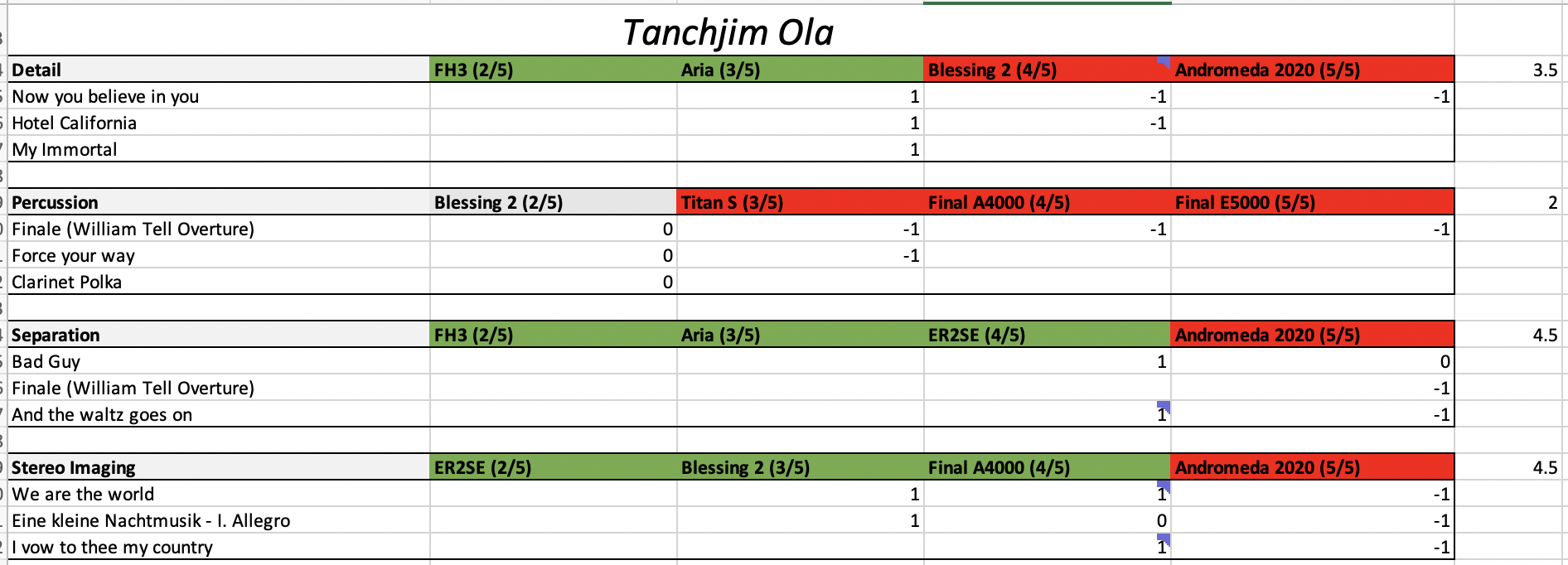
This table shows the results of A/B tests between OLA and the benchmark IEMs. +1 means OLA wins. -1 means OLA loses. 0 means draw. Some tests are too one-sided that conclusions can be reached without further tests.
Stereo Imaging and Layering: 4.5/5
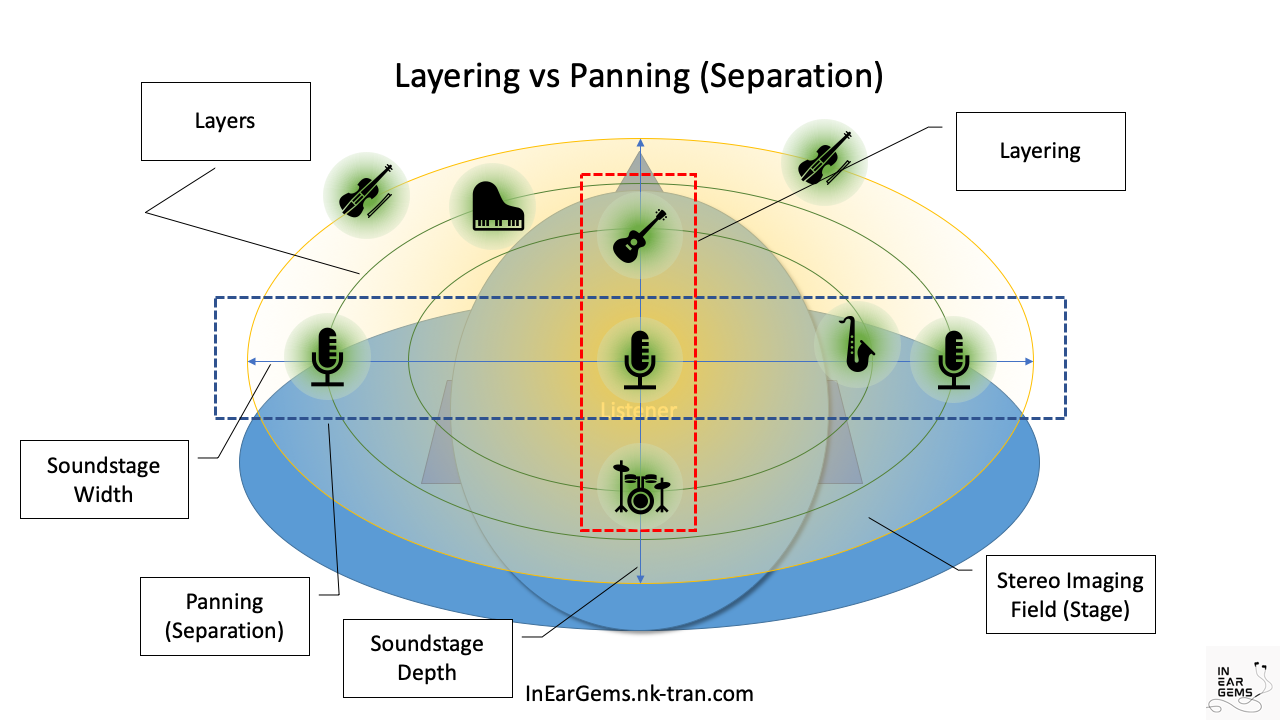 Soundstage, Panning & Width, Layering & Depth
Soundstage, Panning & Width, Layering & Depth
Stereo Imaging is an IEM’s ability to paint an illusion (“image”) of a sound field around a listener. This stereo image is achieved by both recording and mixing technique (stereo widening mixing). Given suitable music, movie, or game, IEMs with good stereo imaging allow you to pin point direction of the sound. Exceptional IEMs can recreate a wide and deep image in which instruments and and vocals form layers from closer to further rather than existing on a the same flat plane.
Test tracks:
- We are the world(3:00 onward): This song shows some excellent stereo imaging. Can you hear soloist upfront whilst the choir is pushed further away to the background? Can you hear one choir to the left and further to the back whilst the other to the right and a bit closer to you?
- Eine kleine Nachtmusik - I. Allegro: Listen for the clear direction of each instrument in the string quartet throughout the piece. You should also be able to hear cello locating closer to than the violin 1.
- I vow to thee, my country: This song is an excellent test for layering. Can you hear the boy choir standing in front of the men choir or they are on the same flat plane?
I was very sceptical when reading the marketing material from Tanchjim about how they tune OLA to “HRTF” (i.e., how a person’s face and ears modify the sound reaching the eardrums) for accurate stereo imaging. The question was: which or whose HRTF?
It turned out my scepticism was unfounded. Perhaps because my HRTF (male, Asian) matches Tanchjim’s target, OLA delivers one of the best stereo imaging performances amongst all IEMs that I have owned or heard.
Before further discussions, I want to remind you that regardless of how impressive these descriptions sound, OLA is still an IEM. The sound still comes from inside or close to your head, never from a virtual “stage” far away from you like how loudspeakers imagine. What OLA provides is a relatively 3D sphere of sound around your head, rather than a wide but flat wall of sounds like many other IEMs and even headphones.
For example, in the chorus of We are the world from 3:00, OLA imagings two choirs furthest from you, one slightly to the left whilst the others to the right. Soloists are upfront and centre, away from the choirs. I vow to thee, my country is another song that showcases OLA’s strong performance in layering. You can hear the boy choir separated from the men’s choir and located closer to you. OLA also places you in the middle of the string quartet in Eine Kleine Nachtmusik - I. Allegro, allowing you to hear the instruments around you, rather than a flat plane that goes from left, through your head, to the right.
The critical limitation of OLA is the lack of bass and lower-mid (i.e., all frequencies below 1khz). This tuning pushes the bass toward the background, reducing the sense of depth and layering that some IEMs like Andromeda and E5000 produce.
Comparison against benchmark IEMs:
- Vs CFA Andromeda 2020 (5/5): OLA is no match due to the lack of lower frequency described above. Andromeda does the depth and layering much better.
- Vs Final Audio A4000 (4/5): Whilst A4000 pushes the image further than OLA, it does not layer elements as well as OLA. In other words, everything is far away on A4000, rather than something closer, something further away at the same time as OLA.
- Vs Moondrop Blessing 2 (3/5): OLA creates a dome of sound, whilst Blessing 2 creates a wide, flat plane. I found OLA more engaging.
- Vs ER2SE (deep insertion) (2/5): OLA creates a larger and more 3D image compared to the narrow and shallow stage of ER2SE. Noted that we are talking about stock ER2SE with the deepest insertion and no EQ.
The benchmarks show that OLA fits between 5/5 and 4/5 levels, so I assign it 4.5/5 for stereo imaging and soundstage. This score puts it behind top-tier performers (Andromeda 2020, Final E5000) but above many peers with wide but flat soundstages like Blessing 2, Aria, Titan S, and similarly tuned IEMs.
Percussion Control: 2/5
Percussion Rendering is about the quality of drum hits, bass guitar, and other percussion instruments, not how loud they are. Exceptional IEMs render bass attacks fast, hard, and maintains precise timing regardless of how busy the bass section becomes. On the other hand, poorly controlled bass is boomy (the bass notes linger too long and blend into others) or mushy (the start of bass notes or drum hits are soft rather than decisive).
Test tracks:
- Finale (William Tell Overture): How rhythmic the whole orchestra sound? Can you follow the drums clearly? How about the rhythm carried by the string and brass section? Can you hear texture and detail in the drum or just mushy thump thump sound?
- Force your way: Is the bass line impactful? Can you hear the melody in the bass or just a series of thump thump sound?
- Clarinet Polka: fun and chaotic polka. Is the drum clean and precise? Is the clarinet on the right well control? How about the accordion on the left?
If the above analysis seems too rosy, then this is where things collapse for OLA. To put it simply, its bass lacks quantity (loudness) and has only mediocre quality, so drums and other rhythmic elements of the music sound dull.
For example, Finale (William Tell Overture) demands snappy attacks of drums, strings, brass, and woodwind section at the same time to deliver its “horse galloping” sensation. OLA does not render attack fast and hard enough, making notes soft and mushed. It does not fare very well with Clarinet Polka for the same reason. Force your way lacks the expected strength. You might be able to hear some details in the bass, but it’s not that great.
Comparison against benchmark IEMs:
- Vs Final E5000 (5/5): Far from the same level.
- Vs Final A4000 (4/5): Far from the same level. A4000 might lack the quantity due to its subdued midbass, but its drum hits are fast, clean, and physical due to its sub-bass extension. You feel the impact in your throat.
- Vs Titan S (3/5): A bit closer in terms of performance level, but the quality of drum hits on Titan S is still better: snappier and stronger.
- Vs Blessing 2 (2/5): More or less the same. Bass attacks are a bit soft, like punching a pillow. Noted that we are talking about the stock Blessing 2 without any EQ.
I rank OLA 2/5 for percussion rendering based on the benchmarks. To put this in context, any score below 3/5 is unsatisfying.
Detail Retrieval: 3.5/5
Detail Retrieval reflects an IEM’s ability to reveal fine details in a mix. Exceptional IEMs are resolving across the frequency spectrum, not just the midrange: you hear more details in the reverb and decay of sound, you hear texture and pitch in the bass, you hear more nuances in instruments and vocal. You usually wouldn’t know that your current IEM lacks detail unless you have heard a more resolving one.
Test tracks:
- Now you believe in you: testing the detail of background element and the treble extension / air
- Hotel California: testing details of the foreground elements from the 12-string guitar.
- My Immortal: testing the detail retrieval across spectrum.
Detail retrieval or “resolution” of OLA is slightly above average. It does a decent job rendering the tail-end reverb and decay of sound in Now you believe in you. The reverb fades away naturally rather than dropping abruptly when going below a certain volume. You can hear little vibratos and details there. The background choir is rendered with decent clarity, allowing you to detect its presence.
“Adequate” also describes how OLA renders Hotel California and My Immortal. You can hear small details when the guitar pick or fingernails catch the strings or the articulation of the left hand on the fingerboard. The notes are still a bit fuzzy around the edge compared to better performers. Still, there is not much to complain about mid-range details in general.
Treble and bass details are where the gap between OLA and better performers shows more clearly. Because we listen to the whole music rather than just midrange or treble or bass, these weaknesses pull the overall “resolution” of OLA down. In some songs, we can compare OLA’s sound to an image that has been overly sharpened rather than taken with good lenses.
Comparison against benchmark IEMs:
- Vs Andromeda 2020 (5/5): The A/B was so lopsided that I did not need to go further after Now you believe in you. OLA is no match.
- Vs Blessing 2 (4/5): OLA was close, but not quite Blessing 2 level yet. With OLA, you tell yourself “hmm, not bad, maybe need a bit more, but not bad …”. With Blessing 2, you can immediately tell yourself “yes, that’s it. Nice and clean”.
- Vs Aria (3/5): This is the A/B I was looking forward to the most. Surprisingly, OLA is just a bit sharper and cleaner than the “average IEM” benchmark. Not hugely, but still better.
- Vs FH3 (2/5): No comparison is necessary. OLA does not have an overly smoothened sound like FH3 (or CFA Satsuma).
Based on the benchmarks, I rate OLA 3.5/5 in terms of detail retrieval, putting it very slightly above average. This score means I would not complain about lack of detail or fuzziness when using OLA.
Separation: 4.5/5
Separation and Layering reflects an IEM’s ability to prevent elements of a mix from overlapping and mushing together. Separation can happen by spreading elements of a mix from left to right, layering them closer to further away, or by accurate rendering of the timbre of different instruments. Given a decent mix, exceptional IEMs allow you to follow every element of the mix with minimal difficulty.
Test tracks:
- Bad guy: Can you hear the duplicated vocal line of Billie Eilish on the left? How easy it is for you to follow the words that she sings?
- Finale (William Tell Overture): Can you follow individual sections the orchestra? Can you hear the woodwind playing at the same time with the string section? Can you hear texture and detail in the drum or just mushy thump thump sound?
- And the waltz goes on: How easy it is to separate different sections of the orchestra when the music gets rich and lush from 1:00 onward?
Due to the tuning and the excellent stereo imaging, OLA performs admirably in separation and layering. It separates and renders elements at the fringe of the soundstage, such as duplicated vocals for stereo widening effect in Bad guy, as well as Andromeda 2020.
However, OLA’s separation crumbles when many things happen in the same region in the soundstage and at similar frequencies. For instance, its separation is worse than Andro in Finale (William Tell Overture). Tracks that demand layering like And the waltz goes on are also the bane of OLA.
Comparison against benchmark IEMs:
- Vs Andromeda 2020 (5/5): OLA falls behind compared to Andromeda when the music gets busy.
- Vs ER2SE (deep insertion) (4/5): OLA pulls ahead slightly thanks to the spacious staging. However, the ability to distinguish different elements in a mix is slightly better on ER2SE.
- Vs Aria (3/5): I found OLA to do a better job than the benchmark due to its staging. Vs FH3 (2/5): While OLA does not separate exceptionally well when elements are bundled together, it still does better than FH3.
Based on the benchmark, I give OLA between 3.5 and 4.5/5, depending on the songs.
Tonality: 3/5
Tonality reflects the timbre and relative loudness of different elements in a mix. The tuning of an IEM can be measured objectively and presented as a frequency response graph. However, the interpretation of tonality from that tuning is more personal due to differences in anatomy, cultural background, and preferences. Therefore, to reduce bias, we assess IEM’s tonality based on how bad they are rather than how good they are. As long as the tuning does not make timbre unrealistic nor reduce technical performance significantly, it is okay.
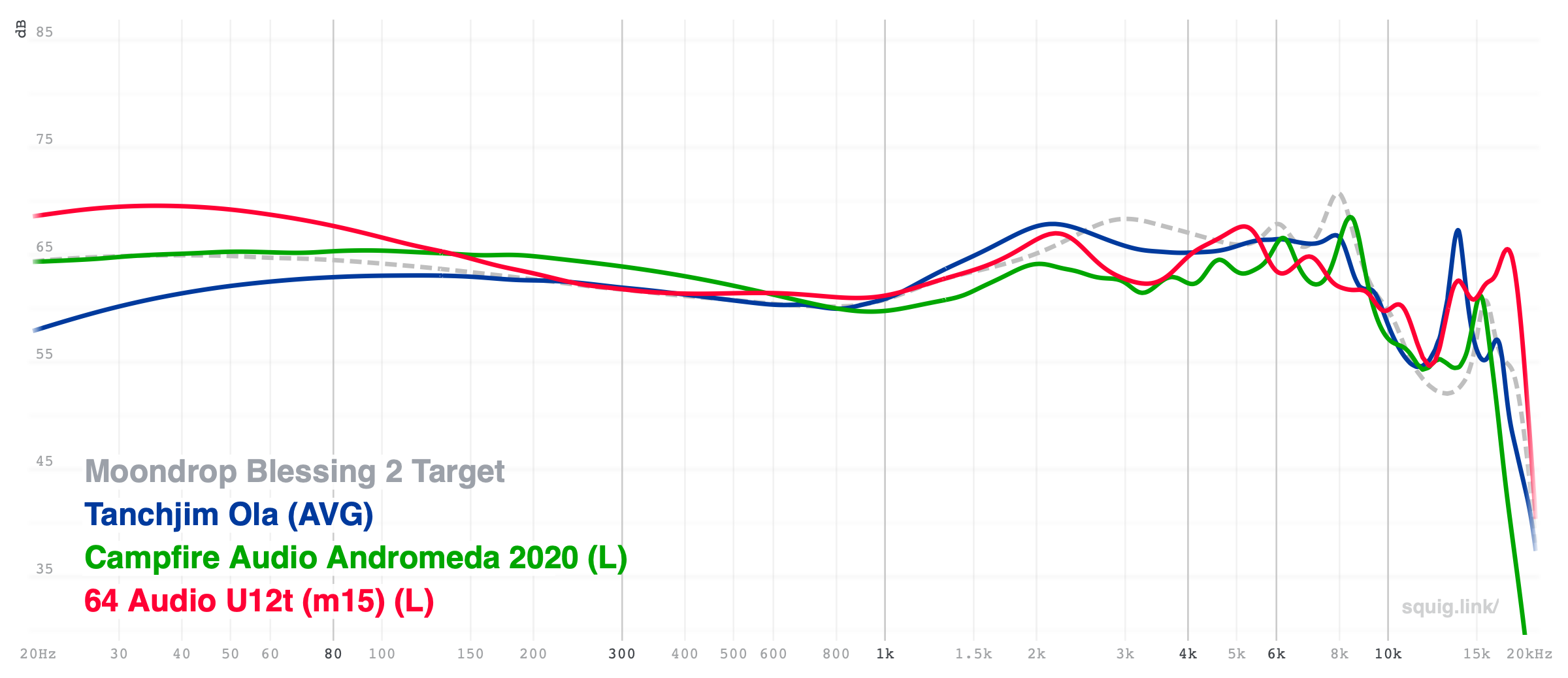 Frequency response graph, courtesy of Super* Review at Squig.Link
Frequency response graph, courtesy of Super* Review at Squig.Link
I was disappointed when listening to OLA the first time. In my impression, I stated that the contrast between upper mid and lower-mid is relatively high compared to the manufacturer’s graph, meaning vocals and instruments are more “in-your-face” but not full-bodied like Final E series, 64 Audio or Andromeda 2020. After weeks of listening and testing, I still have the same opinion.
To be clear, OLA is not a poorly tuned IEM. The instruments and vocals are relatively natural, with no harsh peaks. I believe some would even consider this IEM to be well-tuned, given how perfect it executes the ear gain region.
My issue with OLA is with the area below 1khz. OLA loses richness and details in that region by dipping the fundamental tones. This issue also impacts the soundstage depth. To verify this hypothesis, I use a simple graphical EQ to cut 2.4khz and 4.8khz by 2.5db and boost the lower-mid to match the curve of Final E5000. Lo and behold, the voicing becomes realistic, and depth is created correctly. In this configuration, I have no problem rating OLA’s stereo imaging as 5/5, matching my Andromeda 2020.
In summary, OLA is a fashionably tuned IEM that is not bad on its own, but EQ is highly recommended. Thus, I rate it 3/5: average.
Conclusion and Personal Preference: 4/5
Personal preference is my entirely subjective and personal opinion about an IEM, based on multiple factors. This score DOES NOT contribute to the rating of an IEM.
I give OLA 4/5. I appreciate what Tanchjim has done with stereo imaging, and I hope they know how to repeat that success. I also hope that they further improve these drivers and put them in better shells, like a new Hana or a new Oxygen. If Tanchjim also boosts the lower mid, I believe such IEM would be an end-game worthy for many.
Upgrade path
Should you get OLA if …
- you have no IEM?: Yup. It’s great, but you need to learn how to wear IEM properly and get ready to explore ear tips.
- you have a not-so-great budget IEM?: Yup. Same as above.
- you already have something decent like Aria?: If you don’t want to EQ, then yes. The famous trio (Aria, Titan S, T3+) does not give you this kind of stereo imaging due to their tuning.
- you already have Blessing 2 or higher-end IEM?: Nope. You can use EQ to increase the soundstage depth. Blessing 2 sounds quite 3D with some added lower-mid and reduced ear-gain.
- you want head-shaking, thick, boomy sound?: Nope.
Where to go from OLA:
- More clarity? ER2SE/XR, Blessing 2, Andromeda 2020
- More immersive soundstage? Andromeda 2020 or E5000
- More impactful bass? E3000 or E5000
